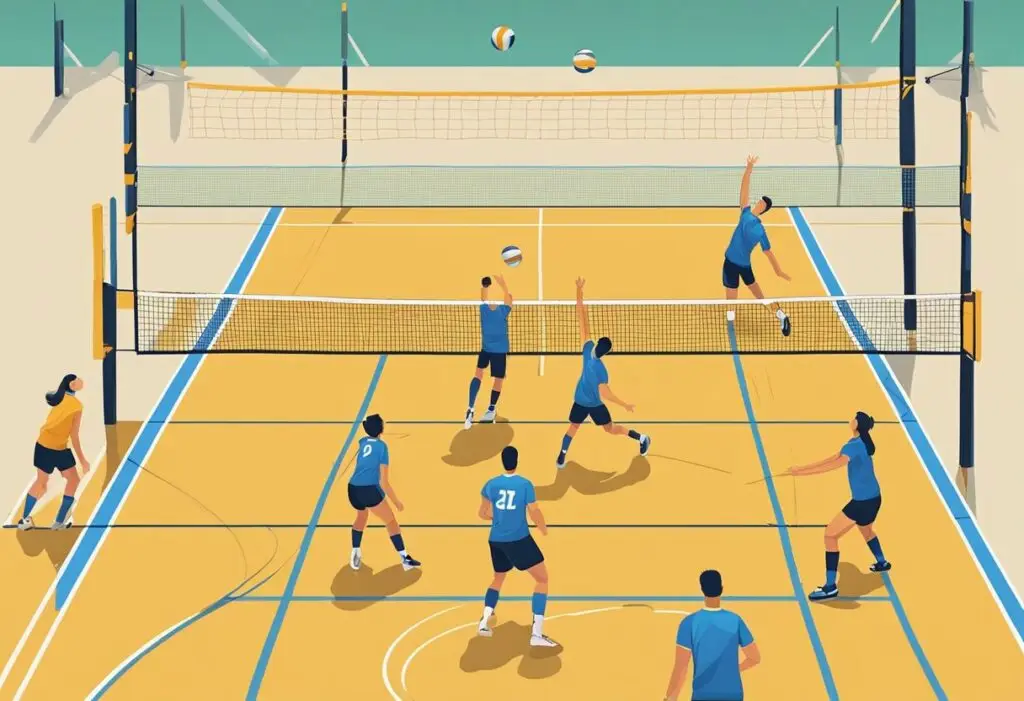The 4-2 volleyball rotation is a popular system used by many teams, especially beginners. This rotation features two setters and four hitters, allowing for a balanced offense and improved scoring options.
Understanding the basics of the 4-2 setup can help players and coaches implement this effective strategy during games.

Key Takeaways
- The 4-2 rotation uses two setters and four hitters for balanced play.
- Understanding player positions and movements enhances team performance.
- Regular practice and in-game adjustments are key to mastering this rotation.
Basics of 4-2 Volleyball Rotation

The 4-2 volleyball rotation is a straightforward offensive system that enables teams to balance attacking and defending roles.
It features two setters and four attackers, providing a solid foundation for team play. Understanding the court positions and their roles, as well as the rotation principles, is essential for effective execution.
Court Positions and Roles
In the 4-2 rotation, players occupy specific positions on the court. The positions are typically divided as follows:
- Setters (2): Positioned in the front row, setters are responsible for delivering accurate sets. They play crucial roles in orchestrating the offense.
- Hitters (4): This group includes two outside hitters and two middle hitters. They work together to attack and score points.
- Libero (1): Although not always included in the 4-2 setup, the libero can help with defense, especially in the back row.
Each player must understand their responsibilities and contribute to team strategies.
Rotation Principles
The rotation in the 4-2 system follows a distinct pattern. Here are key principles:
- Setter Positioning: Both setters remain in the front row when flipping positions, ensuring one is always available to set the ball.
- Attacking Options: With four hitters, the team has multiple attacking possibilities, allowing for diverse plays.
- Position Shifts: After each rally, players should rotate clockwise. This keeps the formation balanced and maximizes player involvement.
Starting Rotation: Understanding Positional Order

In a 4-2 volleyball rotation, knowing the starting positions is key. There are two setters and four hitters on the court. This setup allows flexibility and strategic play.
The players’ positions are usually set up in the following order:
| Position | Player Type |
|---|---|
| Front Row Left | Hitter |
| Front Row Middle | Hitter |
| Front Row Right | Hitter |
| Back Row Left | Setter |
| Back Row Middle | Setter |
| Back Row Right | Hitter |
The setters play crucial roles by setting the ball for the hitters. They occupy the back row and focus on getting into the right position to deliver accurate sets.
Hitters need to position themselves to attack the ball effectively. In the front row, they can directly score points. Their placement allows for quick movements based on the setter’s decisions.
As players rotate, the positions shift, allowing everyone to participate in both offensive and defensive plays. Awareness of these positions helps the team execute strategies more effectively.
Players must communicate well to adapt to changes in position during matches. Knowing where to be and when is essential for success in the 4-2 rotation.
Rotation One: The Initial Setup

The initial setup in the 4-2 volleyball rotation is crucial for a team’s success. It establishes how players are positioned during the serve and how they can effectively attack and defend.
This section covers essential aspects of the serving position, front row dynamics, and back row strategies.
Serving Position: Rotation One
In Rotation One, the serving position is key to setting the tone of the game. The player in the back right serves the ball to start the play. This player must focus on delivering a strong serve, as it can directly influence the opponent’s return.
The setter begins on the front row, which allows them to take advantage of quick plays. This setup enables two attackers to be ready for a spike immediately after the serve.
All players should communicate and be ready to transition quickly after the serve.
Front Row Dynamics
The front row consists of the left side hitter, the middle hitter, and the setter. These three players work together to create offensive opportunities. The setter plays a critical role in determining which hitter will get the ball.
The left and middle hitters should position themselves to receive quick sets. They must also be ready to block any incoming attacks from the opposing team.
Effective communication and positioning can greatly enhance the team’s scoring potential during this rotation.
Back Row Strategies
In Rotation One, the back row includes the right side hitter, libero, and another player who may switch between defensive and offensive roles. The libero plays a defensive role, focusing on receiving serves and passing to the setter.
The back row players should focus on solid passing to set up the front row players for attacks. They must be alert and ready to adjust based on the flow of the game. A strategic back row can provide a strong foundation for successful plays in this rotation.
Rotation Two to Six: Transition and Movement

In the 4-2 volleyball rotation, transitioning between positions is crucial for maintaining both offensive and defensive strategies. Each rotation presents unique opportunities and movements that players must execute effectively.
Rotation Two: Moving to Serve
During rotation two, the focus is on getting the ball into play effectively. The player on the back-right position is responsible for serving. Before serving, she must ensure proper positioning of teammates to prepare for the next play. Communication is vital here.
Each player should know their roles—hitters need to be ready to attack, while setters should anticipate receiving the ball for possible sets. As the serve occurs, movements must be fluid and purposeful, as players will rotate clockwise after the serve, leading them into the next rotation.
Rotation Three: Planning for the Attack
In rotation three, the setters need to prepare for offensive plays. By this time, the setter in the front row must move quickly to set up the hitters effectively. It is essential for the middle hitter to position themselves in a way that they can receive a set comfortably.
The outside hitters should use this time to read the defense. They should also communicate their intentions to the setters. Proper spacing is critical, allowing both hitters to have clear sightlines to the ball and the court. This creates optimal opportunities to score.
Rotation Four: Strengthening Defense
Rotation four requires a strong focus on defense. As players rotate to this position, the setters remain ready to adjust their positions based on the opponent’s attack. The two front-row players should prepare for blocks while the back-row players should remain alert for any possible digs.
Effective communication is also crucial here. Each player must call out their intentions when moving to cover areas of the court. Quick adjustments can make the difference between a successful defense and a point lost.
Rotation Five: Team Synergy
In rotation five, team synergy becomes vital. As players rotate, they must maintain a strong connection both physically and communicatively. The team should practice quick transitions between offensive and defensive plays.
Role clarity is key during this rotation. Players must know who is setting, hitting, and covering during plays. This understanding will help them react swiftly as a single unit.
Team drills focusing on synchronization can improve performance during this rotation.
Rotation Six: Final Adjustments Before Recycle
Rotation six requires players to refine their positions before recycling back to rotation one. The focus is on identifying any adjustments needed based on earlier plays. Setters should analyze their setting angles and hitters should review their approach.
Players should be positioned in a way that allows for effective coverage and attacking. Clear communication is essential, as they confirm their positions and roles before the next serve.
This final adjustment phase is crucial to setting the pace for the upcoming rotations, ensuring all players are prepared for the cycle to restart effectively.
Serving and Receiving Formations

In the 4-2 volleyball rotation, serving and receiving formations are key to a successful strategy. Teams can adjust their formations based on the opponent’s strengths and weaknesses.
For Serving:
- Positioning: The two setters should be positioned at the net. This allows for quick ball movement.
- Offensive Setup: The four hitters can spread out to create multiple attacking options.
For Receiving:
- Alignment: Players will spread in a semi-circle formation to cover the court effectively.
- Roles:
- The liberos often take the main receive positions.
- Setters also help with serve reception.
Serving Strategies:
- Mix short and deep serves to confuse the opponent.
- Aim to target weak passers on the other team.
Receiving Tips:
- Players should communicate clearly.
- Anticipation of the ball’s trajectory is essential for effective movement.
These formations create a balanced offense and defense. Adjustments can be made based on the match conditions. Understanding these strategies helps players execute the 4-2 rotation effectively.
Offensive and Defensive Strategies

In the 4-2 volleyball rotation, teams focus on both strong offensive plays and solid defensive tactics. Effective attacks and well-coordinated defense are essential for success in this formation.
Setting Up Effective Attacks
In a 4-2 rotation, having two setters allows for flexibility in setting up plays. The setters can distribute the ball to four hitters, which helps create a balanced attack.
Key Points:
- Timing: Setters must be aware of court positioning and timing when delivering the ball.
- Hitter Communication: Hitters should communicate their positioning to the setters, ensuring everyone is prepared for the attack.
- Variety in Attacks: Utilizing different angles and types of hits keeps the opponents guessing. Quick sets and outside attacks can be highly effective.
Blocking and Digging: Defensive Focus
Defense is crucial in the 4-2 rotation, where teams need both blocking and digging skills. The middle blockers play a vital role in shutting down opponents’ attacks.
Key Points:
- Effective Blocking: Blockers should stay quick and agile, reacting to the opponent’s hitters. Positioning is key; they must get into the right spot before the ball is hit.
- Reading Plays: Back-row players should focus on anticipating attacks. Good reading skills allow them to dig out spikes and set up counters.
- Transitioning Skills: Players must transition smoothly from offense to defense. This helps close gaps quickly and respond to the opponent’s strategies.
Specialized Player Roles

In a 4-2 volleyball rotation, each player has specific roles that contribute to the team’s success. Understanding these roles is crucial for effective teamwork.
Setters
There are two setters on the court. Their primary job is to deliver accurate sets to the hitters. They rotate with each other and need to be quick thinkers and good communicators.
Hitters
The hitters are positioned to attack the ball. In a 4-2 rotation, there are four main hitters:
- Middle Hitter: Plays close to the net and usually attacks fast balls.
- Outside Hitters: Typically two players who hit from the wings, one on each side. They often handle most of the attacking.
- Opposite Hitter: Positioned across from the setter, they balance the offensive strategy.
Defensive Specialists
Some teams may include defensive specialists who focus solely on defense. They enhance the team’s ability to receive serves and dig attacks.
Libero
The libero is a key defensive player. She cannot attack the ball above the net height but plays a vital role in serve receive and back-row defense. The libero wears a different color jersey for easy identification.
Each position in the 4-2 formation is essential. Proper understanding and execution of these specialized roles help optimize the team’s performance on the court.
Common Rotational Errors: Identifications and Fixes

Understanding common rotational errors is crucial for improving a team’s performance in a 4-2 volleyball rotation. Identifying these errors can help players correct their positions and enhance overall gameplay.
Overlap Faults
Overlap faults occur when players do not maintain the correct positioning relative to each other. In a 4-2 rotation, players must adhere to specific positions at the moment of service. If the front row players are not correctly positioned behind or in front of their back row counterparts, a fault can be called.
To avoid overlap faults, players should consistently review their starting positions before the serve. Here are some steps to help mitigate this issue:
- Communicate: Encourage players to call out positions to ensure clarity.
- Visual Cues: Use markers on the court to help players remember their correct spots.
- Practice: Regular drills focusing on starting positions can improve awareness.
Positional Faults
Positional faults happen when players are out of the required formation during play. In the 4-2 rotation, each setter has specific responsibilities and must be in the right spots to execute plays effectively. If a setter is not in the front row or if hitters are incorrectly positioned, it can disrupt offensive strategies.
To reduce positional faults, teams can implement these strategies:
- Position Checks: Create a routine where players check their alignment frequently.
- Role Clarity: Clearly define each player’s role, ensuring everyone understands their responsibilities on the court.
- Feedback Sessions: After each game, review plays to identify and correct positional errors.
In-Game Adjustments and Adaptations

In a 4-2 volleyball rotation, making in-game adjustments is crucial for success. Coaches and players should be prepared to adapt based on the flow of the match.
Key Adjustments:
- Positioning: Players can shift their positions according to the opponent’s strengths. For instance, if the opposing team has a strong hitter, adjusting the defense to cover that player is vital.
- Substitutions: Timely substitutions can boost energy levels. Replacing fatigued players helps maintain high performance throughout the match.
- Serving Strategy: Changing the serving patterns can disrupt the opponent’s rhythm. A mix of aggressive and tactical serves keeps the other team guessing.
- Communication: Constant communication among players is essential. Callouts during plays help ensure everyone knows their roles and responsibilities.
Adaptations to Make:
- Defensive Formation: If the other team is attacking more effectively, switching to a more defensive setup may be necessary.
- Setter Adjustments: The setter should recognize player matchups. If a hitter is performing well, the setter can focus more on setting them up.
- Pace of Play: Teams can adjust their tempo to either speed up the game or slow it down based on their strategy or opponent’s weaknesses.
Practice Drills for Perfecting Rotation

Practicing the 4-2 volleyball rotation requires specific drills to build skills and teamwork. Here are some effective drills:
- Setter Positioning Drill
Players focus on the setter’s movement. Setters practice moving to the front row while others rotate to their positions. This reinforces spatial awareness. - Passing and Setting Sequence
Divide into two groups. One group passes the ball to the setter, who sets it for the hitters. This improves communication and timing. - Rotation Scrimmage
Organize a short scrimmage. Players practice rotating in real-game situations. They can learn to adapt quickly to the rotation and offensive strategies. - Hitters’ Positioning
Set up a drill for hitters to focus on their movements after each play. They should know where to go after serving or attacking. This drill helps maintain formation. - Defense to Offense Transition
Players practice switching from defense to offense quickly. They learn to rotate into position as soon as the ball is received. - Controlled Environment Drill
Create specific scenarios, like a serve-receive situation. Players follow the rotation rules and practice responding to different plays.
Coaching Tips for 4-2 Rotation

Coaching a 4-2 volleyball rotation can be effective with the right strategies. Here are some important tips:
- Focus on Roles: Each player should know their specific role. Setters need to communicate and direct plays, while hitters should understand their attacking positions.
- Practice Drills: Regular drills focusing on setting, attacking, and defense are vital. Encourage players to practice one skill at a time to build confidence and competence.
- Encourage Communication: Teams need to talk on the court. Players should call for the ball and communicate about their positions. This helps prevent confusion during play.
- Use Game Situations: Simulate game scenarios during practice. This helps players apply what they have learned in real situations, improving their decision-making skills.
- Emphasize Defense: The 4-2 rotation provides solid defensive coverage. Teach players to read the opponent’s offense and position themselves effectively.
- Make Adjustments: Be ready to adapt the rotation based on the team’s strengths and weaknesses. Flexibility can enhance performance during matches.
By implementing these tips, coaches can effectively guide their teams in mastering the 4-2 rotation.
Frequently Asked Questions

The 4-2 volleyball rotation has specific principles, strategic advantages, and player roles that are essential to its success. Understanding how players transition and how the libero fits in adds depth to this system.
What are the basic principles of the 4-2 volleyball rotation system?
In the 4-2 rotation, there are two setters and four hitters. The setters play in the front row, allowing them to set the ball quickly after receiving it. This setup maximizes offensive options while providing ample attacking opportunities for the team.
How does the libero integrate into a 4-2 volleyball rotation?
The libero plays a key defensive role in the 4-2 system. They are mainly stationed in the back row to receive serves and help with defense. The libero can replace any back-row player, allowing for a more flexible defensive strategy without disrupting the team’s rotation.
What are the strategic advantages of using a 4-2 rotation compared to a 6-2 or 5-1 rotation?
The 4-2 rotation offers more attacking options with two setters in the front row. This setup can lead to quicker plays and more diverse attacking angles. Compared to the 6-2 rotation, it provides better overall offensive balance, while also being simpler to implement than the 5-1 system.
How do players transition between positions in the 4-2 volleyball rotation during serve receive?
During serve receive, players must communicate effectively to ensure proper positioning. Typically, outside hitters will move into positions that best support the setters. It is important for players to anticipate shifts based on serve placement and adjust their formations quickly.
What is the role distribution for players in a 4-2 volleyball system?
In the 4-2 system, two players take on the setter role, while the other four players are primarily attackers. Middle hitters, outside hitters, and the libero all have specific roles to support the setter and enhance the offensive strategy. Each player’s understanding of their responsibilities is crucial for success.
Can you explain the serve receive patterns in a 4-2 volleyball rotation setup?
In a typical serve receive pattern for the 4-2 rotation, the team often sets up with two passers in the front row and two in the back. The outside hitter usually takes the lead in passing, while the other players position themselves to cover any gaps. This pattern enhances the team’s ability to control serves and set up effective plays.



